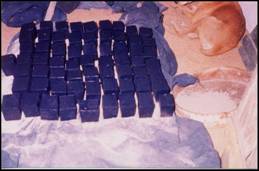|
|
|
|
|
|
|
|
 |
|
|
|
||||
|
|
Concern for the environment and the increasing awareness on the benefits of natural dyes have led to research at this Centre on these dyes as well as on the sources and methods of extraction of these. The highly innovative approaches in past one decade yielded novel technology packages on natural dyes. The first such investigation at MCRC was on indigo production from Indigofera tinctoria. MCRC could develop a new dimension technology that yields higher amounts of indigo as against the traditional method of indigo extraction followed by farmers. The research on indigo, a major requirement of dyeing industry is a milestone in the field of biological dye extraction. A package of simplified technology has been developed first in the world for transfer to villages so as to benefit women and traditional farmers. Special tanks which could serve for both soaking the harvested indigo plants for fermentation and then for oxidation of the fermented liquid have been designed and erected. Use of special nets to hold the plants during the soaking and fermentation processes prevents plant debris from contaminating the dye preparation. A mechanical agitator specially designed and fabricated at MCRC facilitates rapid oxidation of the fermented plant extracts. These innovations minimizes the time for the extraction process and augments the quantity and quality of the dye. MCRC is currently disseminating this technological advancement in Indigo extraction methodology to various traditional indigo farmers through workshops and training programmes under a CAPART funded All India Coordinated project on Natural dyes. Further improvements in the infrastructure needs for indigo extraction are being studied now. The extraction methods, characterisation and application of dyes from other sources like Cassia augustifolia, Peltaphorum ferrugeneum, Bixa orellana, Jatropha curcas as well as certain bacteria, fungi, algae and lichens are also being investigated. Extraction of some coloured compounds from a few microbes in the laboratory has already been achieved. Studies on the properties of dyes from the microbes and the higher plants under investigation as well as on the use of natural dyes in paper and textile industries are being pursued now. Highlights of Natural Indigo Technology Indigo technology involves cultivation of indigo plant by novel organic farming method, which improved dye content in plant. Production of good quantity of quality indigo dye by phototrophic/ heterotrophic (friendly) bacterial fermentation. New design of indigo tank construction with cement moulded rings, which is more economical and occupies less space. The tank serves the dual purpose of soaking the plant for fermentation and to oxidise the ferment liquid. In the fermentation process, use of Netlon soaking set-up aids in preventing the plant debris in final indigo cake and a special mechanical agitator with cycle setup was designed and fabricated which increases the rate of effective oxidation. This technology minimizing the duration of extraction process from that of the conventional process with increased quantity and quality of dye. Indigo technology has been transferred to different farmer communities and industrial sectors through series of workshops and training programmes. This technology is being patented. This technology package is available for transfer and is suitable for women entrepreneurs
|
|
|
|

